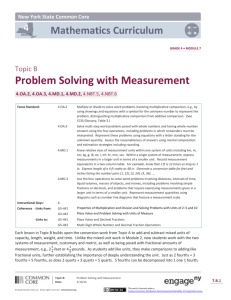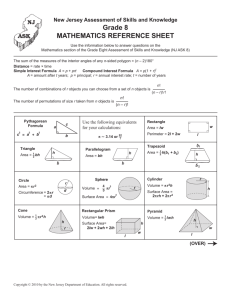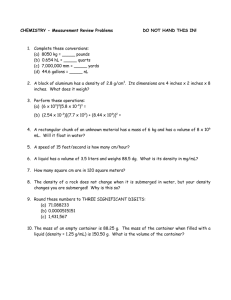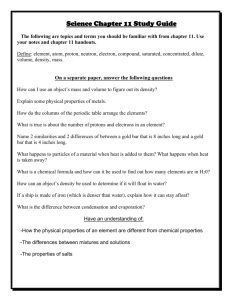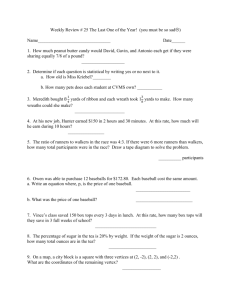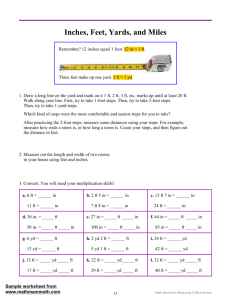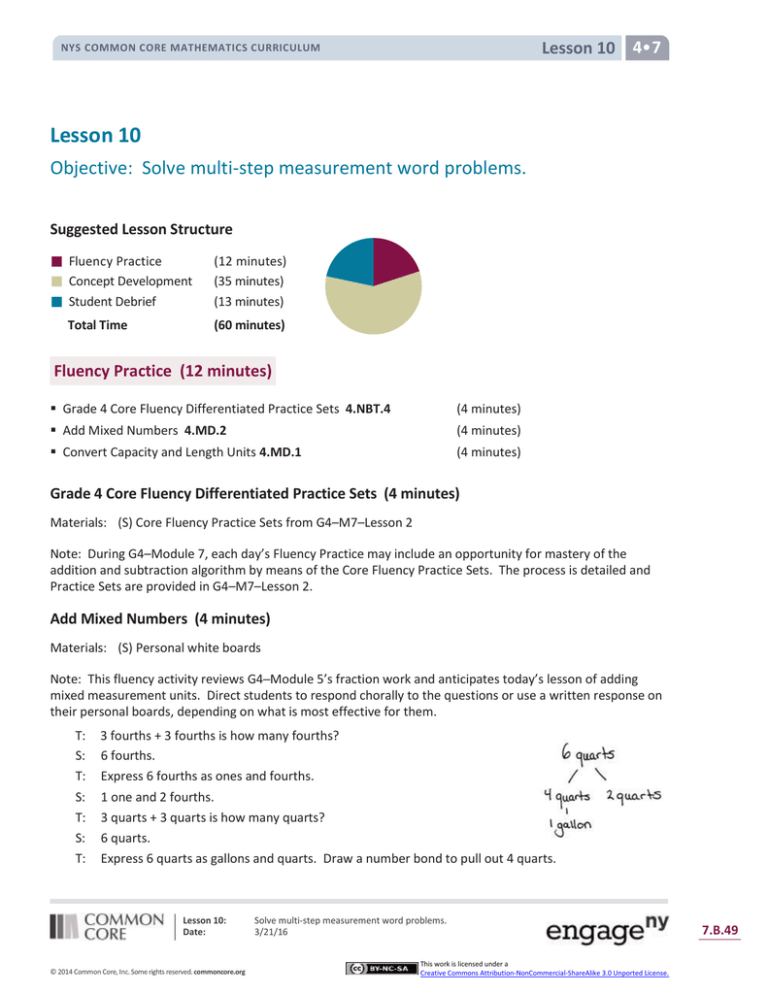
Lesson 10 4•7
NYS COMMON CORE MATHEMATICS CURRICULUM
Lesson 10
Objective: Solve multi-step measurement word problems.
Suggested Lesson Structure
Fluency Practice
Concept Development
Student Debrief
Total Time
(12 minutes)
(35 minutes)
(13 minutes)
(60 minutes)
Fluency Practice (12 minutes)
Grade 4 Core Fluency Differentiated Practice Sets 4.NBT.4
(4 minutes)
Add Mixed Numbers 4.MD.2
(4 minutes)
Convert Capacity and Length Units 4.MD.1
(4 minutes)
Grade 4 Core Fluency Differentiated Practice Sets (4 minutes)
Materials: (S) Core Fluency Practice Sets from G4–M7–Lesson 2
Note: During G4–Module 7, each day’s Fluency Practice may include an opportunity for mastery of the
addition and subtraction algorithm by means of the Core Fluency Practice Sets. The process is detailed and
Practice Sets are provided in G4–M7–Lesson 2.
Add Mixed Numbers (4 minutes)
Materials: (S) Personal white boards
Note: This fluency activity reviews G4─Module 5’s fraction work and anticipates today’s lesson of adding
mixed measurement units. Direct students to respond chorally to the questions or use a written response on
their personal boards, depending on what is most effective for them.
T:
S:
T:
S:
T:
S:
T:
3 fourths + 3 fourths is how many fourths?
6 fourths.
Express 6 fourths as ones and fourths.
1 one and 2 fourths.
3 quarts + 3 quarts is how many quarts?
6 quarts.
Express 6 quarts as gallons and quarts. Draw a number bond to pull out 4 quarts.
Lesson 10:
Date:
© 2014 Common Core, Inc. Some rights reserved. commoncore.org
Solve multi-step measurement word problems.
3/21/16
This work is licensed under a
Creative Commons Attribution-NonCommercial-ShareAlike 3.0 Unported License.
7.B.49
Lesson 10 4•7
NYS COMMON CORE MATHEMATICS CURRICULUM
S:
T:
S:
T:
S:
T:
S:
T:
S:
1 gallon 2 quarts.
7 twelfths + 7 twelfths is how many twelfths?
14 twelfths.
Express 14 twelfths as ones and twelfths.
1 one and 2 twelfths.
7 inches + 7 inches is how many inches?
14 inches.
Express 14 inches as feet and inches. Draw a number bond to pull out
12 inches.
1 foot 2 inches.
Repeat the process using the following possible sequence: 6 eighths + 6 eighths related to 6 pints + 6 pints,
and 11 sixteenths + 11 sixteenths related to 11 ounces + 11 ounces.
Convert Capacity and Length Units (4 minutes)
Materials: (S) Personal white boards
Note: This fluency activity reviews G4─M7─Lessons 1─2 and anticipates today’s work with capacity and
length units. Direct students to respond chorally to the questions at a signal or to use written responses on
their personal boards, depending on what is most effective for them.
T:
T:
S:
T:
S:
T:
T:
S:
T:
S:
T:
S:
Express each number of quarts and cups as cups..
1 quart.
4 cups.
1 quart 2 cups.
6 cups.
Express each number of feet and inches as inches.
1 foot 1 inch.
13 inches.
2 quarts 3 cups.
11 cups.
3 feet 7 inches.
43 inches.
NOTES ON
MULTIPLE MEANS OF
REPRESENTATION:
To clarify the Convert Capacity and
Length Units fluency activity directions
for English language learners and
others, give an example demonstrating
the anticipated response.
Repeat the same process with gallons and pints, then yards and feet.
Concept Development (35 minutes)
Materials: (S) Problem Set
Note: The sample solutions for each problem are examples of the type of thinking that students might use in
Lesson 10:
Date:
© 2014 Common Core, Inc. Some rights reserved. commoncore.org
Solve multi-step measurement word problems.
3/21/16
This work is licensed under a
Creative Commons Attribution-NonCommercial-ShareAlike 3.0 Unported License.
7.B.50
Lesson 10 4•7
NYS COMMON CORE MATHEMATICS CURRICULUM
solving each problem. The solutions are not inclusive of all possible strategies. Encourage and challenge
students to explain the strategies that they use.
Suggested Delivery of Instruction for Solving Lesson 10’s Word Problems
For Problems 1─4 below, students may work in pairs to solve each of the problems using the RDW approach
to problem solving.
1. Model the problem.
Select two pairs of students who can successfully model the
problem to work at the board while the other students work
independently or in pairs at their seats. Review the following
questions before beginning the first problem.
NOTES ON
MULTIPLE MEANS OF
ENGAGEMENT:
Communicate clear expectations for
modeling that will allow all students to
understand what it takes to become a
demonstrating student. Offering a
rubric and scaffolds by which students
can set and achieve goals may give
everyone a fair chance to succeed.
Demonstrating students may use
translators, interpreters, or sentence
frames to present and respond to
feedback.
Can you draw something?
What can you draw?
What conclusions can you make from your drawing?
As students work, circulate. Reiterate the questions above.
After two minutes, have the two pairs of students share only
their labeled diagrams. For about one minute, have the
demonstrating students receive and respond to feedback and
questions from their peers.
2. Calculate to solve and write a statement.
Allow students two minutes to complete work on the problem, sharing their work and thinking with a peer.
Have the students write their equations and statements of the answer.
3. Assess the solution.
Give students one to two minutes to assess the solutions presented by their peers on the board, comparing
the solutions to their own work. Highlight alternative methods to reach the correct solution.
Lesson 10:
Date:
© 2014 Common Core, Inc. Some rights reserved. commoncore.org
Solve multi-step measurement word problems.
3/21/16
This work is licensed under a
Creative Commons Attribution-NonCommercial-ShareAlike 3.0 Unported License.
7.B.51
Lesson 10 4•7
NYS COMMON CORE MATHEMATICS CURRICULUM
Problem 1
Paula’s time swimming in the Ironman Triathlon was 1 hour 25 minutes. Her time biking was 5 hours longer
than her swimming time. She ran for 4 hours 50 minutes. How long did it take her to complete all three parts
of the race?
This problem could be solved, as in Solution A, by adding like units. Students may also, as in Solution B, solve
by adding up. First, the student adds the 2 equal units of 1 hour 25 minutes and then adds the additional 5
hours. Then, the student adds the remaining 4 hours and 50 minutes, decomposing 50 minutes into 10
minutes and 40 minutes as to complete the whole, the next hour.
Lesson 10:
Date:
© 2014 Common Core, Inc. Some rights reserved. commoncore.org
Solve multi-step measurement word problems.
3/21/16
This work is licensed under a
Creative Commons Attribution-NonCommercial-ShareAlike 3.0 Unported License.
7.B.52
Lesson 10 4•7
NYS COMMON CORE MATHEMATICS CURRICULUM
Problem 2
Nolan put 7 gallons 3 quarts of gas into his car on Monday and twice as much on Saturday. What was the
total amount of gas put into the car on both days?
MP.2
Once students see the relationship between the amount of gas added on Monday and Saturday, they can use
different strategies to figure out how much gas was put in the car. The amount of gas can be converted into
quarts, as modeled in Solution A, or the student may work with the mixed units to get 23 gallons 1 quart of
gas as shown in Solution B. Solution C shows an alternative method of rounding the gas for each unit to 8
gallons, finding about 24 gallons of gas was put into Nolan’s car. Each unit was rounded up by 1 quart, so
then 3 quarts, 1 quart for each unit, is subtracted for 24 gallons.
Lesson 10:
Date:
© 2014 Common Core, Inc. Some rights reserved. commoncore.org
Solve multi-step measurement word problems.
3/21/16
This work is licensed under a
Creative Commons Attribution-NonCommercial-ShareAlike 3.0 Unported License.
7.B.53
Lesson 10 4•7
NYS COMMON CORE MATHEMATICS CURRICULUM
Problem 3
One pumpkin weighs 7 pounds 12 ounces. A second pumpkin weighs 10 pounds 4 ounces. A third pumpkin
weighs 2 pounds 9 ounces more than the second pumpkin. What is the total weight of all three pumpkins?
Solution A models the arrow way of adding up. First, the weight of the third pumpkin is determined. Next,
the three weights are added together to find their total weight. Solution B uses mixed unit addition, first
finding the weight of the third pumpkin and then adding all three weights together. A number bond shows
how 1 pound can be taken out of 29 ounces, just as 1 whole can be taken out of 5 fourths. Solution C models
using multiplication to find the weight of the full unit of the second pumpkin and the partial unit of the third
pumpkin. Then, the additional weight of the third pumpkin and the weight of the first pumpkin are added on.
All three solutions shown are computed in mixed units, as converting all weights to ounces and then finding
their sum would be inefficient, but a possible strategy.
Lesson 10:
Date:
© 2014 Common Core, Inc. Some rights reserved. commoncore.org
Solve multi-step measurement word problems.
3/21/16
This work is licensed under a
Creative Commons Attribution-NonCommercial-ShareAlike 3.0 Unported License.
7.B.54
Lesson 10 4•7
NYS COMMON CORE MATHEMATICS CURRICULUM
Problem 4
Mr. Lane is 6 feet 4 inches tall. His daughter, Mary, is 3 feet 8 inches shorter than her father. His son is 9
inches taller than Mary. How many inches taller is Mr. Lane than his son?
As in Solution A, students may notice from the tape diagrams that they don’t need to find Mary’s height or
the son’s heights to solve this problem. They can subtract the 9 inches from the 3 feet 8 inches to see how
much taller Mr. Lane is than his son. As shown in Solution B, students can use the given information to find
Mary’s height and then add 9 inches to find the son’s height. The son’s height can be subtracted from Mr.
Lane’s height to find the difference, and then the difference can be converted to inches to find the solution.
Breaking out a foot to subtract the inches makes the subtraction process easier.
Student Debrief (13 minutes)
Lesson Objective: Solve multi-step measurement word problems.
The Student Debrief is intended to invite reflection and active processing of the total lesson experience.
Invite students to review their solutions for the Problem Set. They should check work by comparing answers
with a partner before going over answers as a class. Look for misconceptions or misunderstandings that can
be addressed in the Debrief. Guide students in a conversation to debrief the Problem Set and process the
lesson.
You may choose to use any combination of the questions below to lead the discussion.
Look at Problem 2. Discuss with your partner which of your solutions is more efficient.
Is it more efficient to add or multiply for Problem 2? How does that choice affect the units of the
solution?
Lesson 10:
Date:
© 2014 Common Core, Inc. Some rights reserved. commoncore.org
Solve multi-step measurement word problems.
3/21/16
This work is licensed under a
Creative Commons Attribution-NonCommercial-ShareAlike 3.0 Unported License.
7.B.55
Lesson 10 4•7
NYS COMMON CORE MATHEMATICS CURRICULUM
Explain to your partner how you solved Problem
3. If you used different strategies, discuss how
you arrived at the same answer.
For Problem 3, is 29 pounds 29 ounces a correct
answer? Explain.
Let’s look at how two different students modeled
Problem 4. How are they similar? How are they
different?
For Problem 4, how did the drawing of the tape
diagram help to find the more efficient way to
solve? Why didn’t you have to determine Mary’s
height or the son’s height to solve?
When might it be better to work with the mixed
units rather than converting to the smaller unit?
What are the advantages to knowing several
methods for working with units of measurement?
Exit Ticket (3 minutes)
After the Student Debrief, instruct students to complete
the Exit Ticket. A review of their work will help you assess
the students’ understanding of the concepts that were
presented in the lesson today and plan more effectively for
future lessons. You may read the questions aloud to the
students.
Lesson 10:
Date:
© 2014 Common Core, Inc. Some rights reserved. commoncore.org
Solve multi-step measurement word problems.
3/21/16
This work is licensed under a
Creative Commons Attribution-NonCommercial-ShareAlike 3.0 Unported License.
7.B.56
NYS COMMON CORE MATHEMATICS CURRICULUM
Lesson 10 Problem Set 4•7
Name
Date
Use RDW to solve the following problems.
1. Paula’s time swimming in the Ironman Triathlon was 1 hour 25 minutes. Her time biking was 5 hours
longer than her swimming time. She ran for 4 hours 50 minutes. How long did it take her to complete all
three parts of the race?
2. Nolan put 7 gallons 3 quarts of gas into his car on Monday and twice as much on Saturday. What was the
total amount of gas put into the car on both days?
Lesson 10:
Date:
© 2014 Common Core, Inc. Some rights reserved. commoncore.org
Solve multi-step measurement word problems.
3/21/16
This work is licensed under a
Creative Commons Attribution-NonCommercial-ShareAlike 3.0 Unported License.
7.B.57
NYS COMMON CORE MATHEMATICS CURRICULUM
Lesson 10 Problem Set 4•7
3. One pumpkin weighs 7 pounds 12 ounces. A second pumpkin weighs 10 pounds 4 ounces. A third
pumpkin weighs 2 pounds 9 ounces more than the second pumpkin. What is the total weight of all three
pumpkins?
4. Mr. Lane is 6 feet 4 inches tall. His daughter, Mary, is 3 feet 8 inches shorter than her father. His son is 9
inches taller than Mary. How many inches taller is Mr. Lane than his son?
Lesson 10:
Date:
© 2014 Common Core, Inc. Some rights reserved. commoncore.org
Solve multi-step measurement word problems.
3/21/16
This work is licensed under a
Creative Commons Attribution-NonCommercial-ShareAlike 3.0 Unported License.
7.B.58
Lesson 10 Exit Ticket 4•7
NYS COMMON CORE MATHEMATICS CURRICULUM
Name
Date
Use RDW to solve the following problem.
1. Hadley spent 1 hour and 20 minutes completing her math homework, 45 minutes completing her social
studies homework, and 30 minutes studying her spelling words. How much time did Hadley spend on
homework and studying?
Lesson 10:
Date:
© 2014 Common Core, Inc. Some rights reserved. commoncore.org
Solve multi-step measurement word problems.
3/21/16
This work is licensed under a
Creative Commons Attribution-NonCommercial-ShareAlike 3.0 Unported License.
7.B.59
Lesson 10 Homework 4•7
NYS COMMON CORE MATHEMATICS CURRICULUM
Name
Date
Use RDW to solve the following problems.
1. On Saturday, Jeff used 2 quarts 1 cup of water from a full gallon to replace some water that leaked from
his fish tank. On Sunday, he used 3 pints of water from the same gallon. How much water was left in the
gallon after Sunday?
2. To make punch, Julia poured 1 quart 8 ounces of ginger ale into a bowl and then added twice as much
fruit juice. How much punch did she make in all?
3. Patti went swimming for 1 hour 15 minutes on Monday. On Tuesday, she swam twice as long as she
swam on Monday. On Wednesday, she swam 50 minutes less than the time she swam on Tuesday. How
much time did she spend swimming during that three day period?
Lesson 10:
Date:
© 2014 Common Core, Inc. Some rights reserved. commoncore.org
Solve multi-step measurement word problems.
3/21/16
This work is licensed under a
Creative Commons Attribution-NonCommercial-ShareAlike 3.0 Unported License.
7.B.60
Lesson 10 Homework 4•7
NYS COMMON CORE MATHEMATICS CURRICULUM
4. Myah is 4 feet 2 inches tall. Her sister, Ally, is 10 inches taller. Their little brother is half as tall as Ally.
How tall is their little brother in feet and inches?
5. Rick and Laurie have three dogs. Diesel weighs 89 pounds 12 ounces. Ebony weighs 33 pounds 14 ounces
less than Diesel. Luna is the smallest at 10 pounds 2 ounces. What is the combined weight of the three
dogs in pounds and ounces?
Lesson 10:
Date:
© 2014 Common Core, Inc. Some rights reserved. commoncore.org
Solve multi-step measurement word problems.
3/21/16
This work is licensed under a
Creative Commons Attribution-NonCommercial-ShareAlike 3.0 Unported License.
7.B.61

